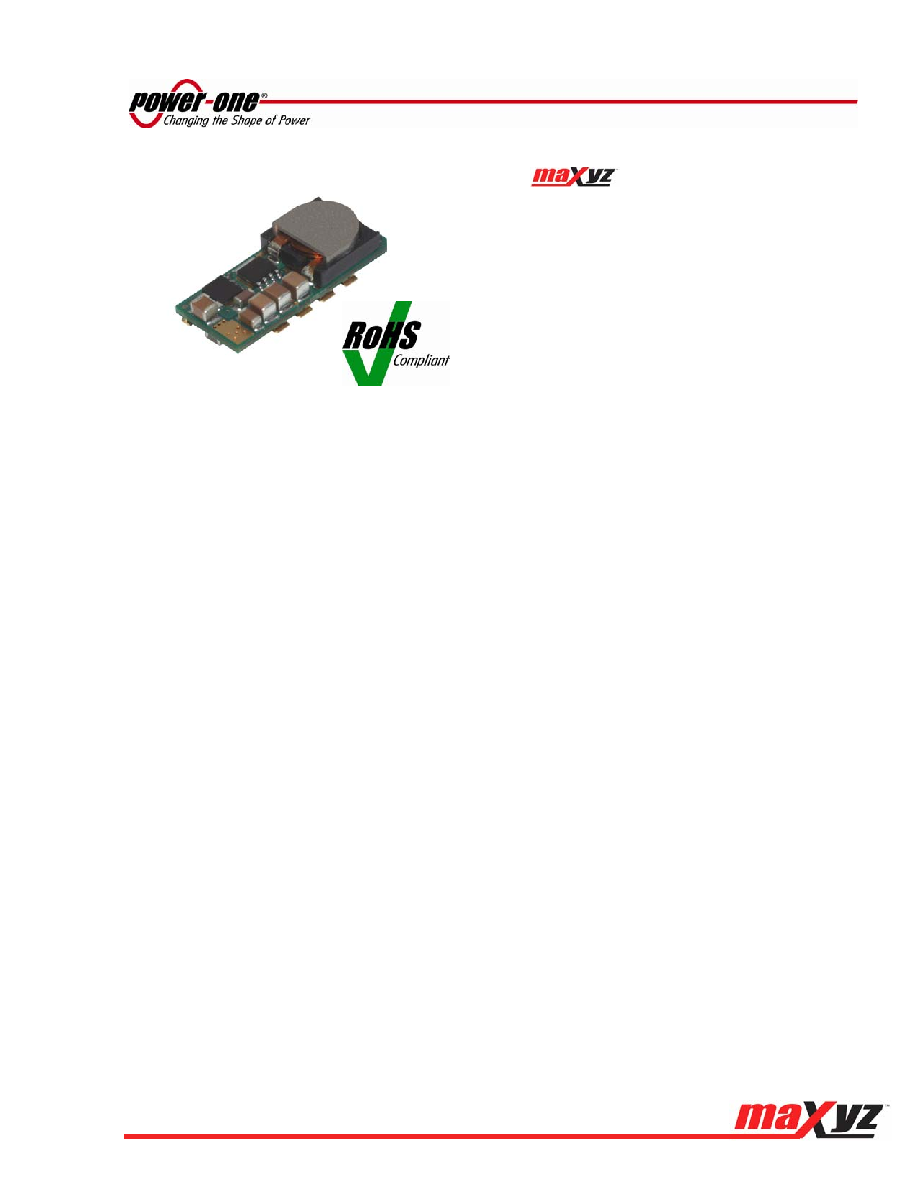- 您現(xiàn)在的位置:買賣IC網(wǎng) > PDF目錄48103 > YNC05S20-0-G (POWER-ONE INC) 1-OUTPUT DC-DC REG PWR SUPPLY MODULE PDF資料下載
參數(shù)資料
| 型號: | YNC05S20-0-G |
| 廠商: | POWER-ONE INC |
| 元件分類: | 電源模塊 |
| 英文描述: | 1-OUTPUT DC-DC REG PWR SUPPLY MODULE |
| 文件頁數(shù): | 1/26頁 |
| 文件大小: | 386K |
| 代理商: | YNC05S20-0-G |

OCT 02, 2006 revised to APR 23, 2007
Page 1 of 26
www.power-one.com
YNC05S20 DC-DC Converter Data Sheet
4.5-5.5 VDC Input; 0.7525-3.63 VDC Programmable @ 20A
Applications
Intermediate Bus Architectures
Telecommunications
Data communications
Distributed Power Architectures
Servers, workstations
Benefits
High efficiency – no heat sink required
Reduces total solution board area
Tape and reel packing
Compatible with pick & place equipment
Minimizes part numbers in inventory
The
Products: Y-Series
Features
RoHS lead free solder and lead solder exempted
products are available
Delivers up to 20 A (66 W)
Surface-mount package
Industry-standard footprint and pinout
Small size and low profile: 1.30” x 0.53” x 0.314”
(33.02 x 13.46 x 7.98 mm)
Weight: 0.22 oz [6.12 g]
Coplanarity less than 0.003”, maximum
Synchronous Buck Converter topology
Source and sink capable
Start-up into pre-biased output
No minimum load required
Programmable output voltage via external resistor
Operating ambient temperature: -40 °C to 85 °C
Remote output sense
Remote ON/OFF (positive or negative)
Fixed-frequency operation
Auto-reset output overcurrent protection
Auto-reset overtemperature protection
High reliability, MTBF = TBD Million Hours
All materials meet UL94, V-0 flammability rating
UL 60950 recognition in U.S. & Canada, and DEMKO
certification per IEC/EN 60950
Description
The YNC05S20 non-isolated DC-DC converter delivers up to 20 A of output current in an industry-standard
surface-mount package. Operating from a 4.5 – 5.5V input, this converter is an ideal choice for Intermediate
Bus Architectures where point-of-load power delivery is preferred. It provides an extremely-tight, regulated
programmable output voltage of 0.7525 V to 3.63 V.
The YNC05S20 converter provides exceptional thermal performance, even in high temperature environments
with minimal airflow. This is accomplished through the use of patent pending circuits, packaging, and
processing techniques to achieve ultra-high efficiency and excellent thermal management.
The preclusion of heat sinks minimizes impedance to system airflow, thus enhancing cooling for both
upstream and downstream devices. The use of 100% automation for assembly, coupled with advanced power
electronics and thermal design, results in a product with extremely high reliability.
相關(guān)PDF資料 |
PDF描述 |
|---|---|
| YNC05S20-0 | 1-OUTPUT DC-DC REG PWR SUPPLY MODULE |
| YNC05S20-D | 1-OUTPUT DC-DC REG PWR SUPPLY MODULE |
| YNC05S20-D-G | 1-OUTPUT DC-DC REG PWR SUPPLY MODULE |
| YNC12S20-0G | 1-OUTPUT 100 W DC-DC REG PWR SUPPLY MODULE |
| YNC12S20-DS1 | 1-OUTPUT DC-DC REG PWR SUPPLY MODULE |
相關(guān)代理商/技術(shù)參數(shù) |
參數(shù)描述 |
|---|---|
| YNC05S20-D | 制造商:Power-One 功能描述:Module DC-DC 1-OUT 0.7525V to 3.63V 20A 66W 6-Pin SMD |
| YNC05S20-DG | 制造商:Power-One 功能描述: |
| YNC10S20A-0 | 制造商:POWER-ONE 制造商全稱:Power-One 功能描述:9.6-14 VDC Input; 0.7525-5.5 VDC Programmable 20 A |
| YNC10S20A-0G | 制造商:POWER-ONE 制造商全稱:Power-One 功能描述:9.6-14 VDC Input; 0.7525-5.5 VDC Programmable 20 A |
| YNC10S20A-D | 制造商:POWER-ONE 制造商全稱:Power-One 功能描述:9.6-14 VDC Input; 0.7525-5.5 VDC Programmable 20 A |
發(fā)布緊急采購,3分鐘左右您將得到回復(fù)。